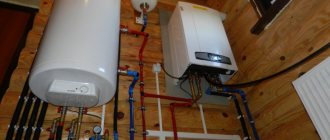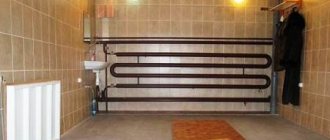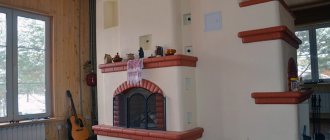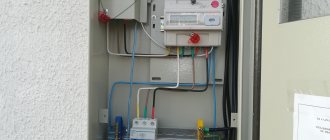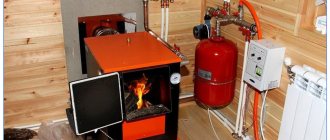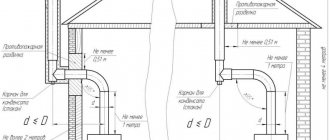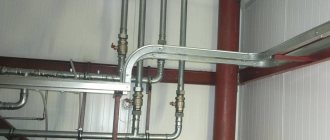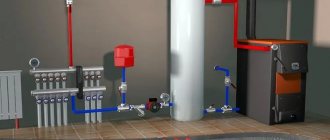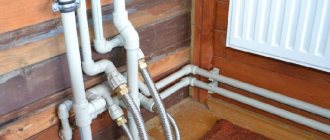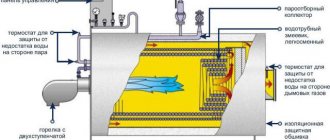- What determines the cost of heating a house?
- The most accessible and cheapest type of fuel
- Types of heating devices
- Electrical
- Heat guns
- Oil radiators
- Electric convectors
- Infrared heater
- Ceramic
- Convectors
- Infrared
- Catalytic
- Solar collectors
With the onset of the autumn-winter period, summer residents are faced with a pressing question: how to heat the garden house? The choice of different devices is huge. But how not to get lost in all the diversity? How to choose an effective device specifically for your case? Let's figure it out together and choose the best option for heating a small country house from 18 to 36 square meters, because there are most of these types of buildings.
Spoiler for the impatient. The most profitable method is combined. The main source is a wood stove or fireplace stove (read our rating of stoves for a country house). And after the dacha has warmed up, convectors are connected to maintain the temperature regime. So, in order.
The choice of heater is made based on the following conditions:
- Permanent residence in a holiday village or visiting on Sundays and holidays;
- Availability of communications
- Is electricity and gas supplied to the dacha?
- Is the device intended for heating only or is water heating also required?
- Economic and operational indicators of devices.
What determines the cost of heating a house?
Before thinking about heating the dacha, it is necessary to ensure its insulation. This usually happens during the construction phase. It is necessary to start insulation from the foundation of the country house. Wall insulation should be at least 100 mm. Insulate the ceiling and floor.
In this case, the cost of heating the room will be reduced.
Important Calculation of heat losses has a complex formula. It takes into account all the components of the building, number of floors, wall material, number of doors and windows, ceiling height, region. In practice, a simplified calculation is carried out based on the area. Heating 10 m2 requires 1 kW of power, but this does not take into account the height of the ceilings. Therefore, using volume, the result is more accurate. For 25 m3 you will need to spend 1 kW of power.
The cost of equipment and the type of fuel used play an important role. The latter depends on the infrastructure of the holiday village or SNT.
Let's go through everything in order
Stone wool can be used to insulate walls, roofs and wooden floors along joists. This is an ideal option for facades, since such wool is non-flammable, vapor-permeable and allows structures to “breathe”.
XPS boards made of extruded polystyrene foam are highly durable, do not absorb water and do not rot, so they can be used not only for wall insulation, but also for plinths, basements, blind areas and flat roofs.
PIR thermal insulation boards based on polyisocyanurate foam are a new generation of insulation materials. They have a low thermal conductivity coefficient, so they are effective in situations where you need to preserve usable space: for insulating balconies, verandas, bathrooms, baths, floors, etc.
The most accessible and cheapest type of fuel
The most expensive fuel is electricity. But its use has many advantages. There are no additional labor costs, no exhaust gas removal required. At the same time, the summer resident depends on the stability of the electrical system.
Mains gas is preferable in terms of operating costs. But its supply costs a lot of money. And the equipment is not cheap.
The use of liquefied gas in cylinders has a significant drawback. For cylinders it is necessary to make a special box outdoors, which makes operation difficult. And with constant use, it quickly ends. You will have to constantly travel and refill cylinders.
The use of solid fuel significantly reduces operating costs if the cottage is located near a forest and firewood can be taken there. Moreover, on every site there are bushes and trees that need to be pruned or removed every year.
We can conclude that the cheapest type of fuel is firewood
. Provided that you can prepare them yourself. The cost of purchasing imported raw materials is comparable to liquefied gas.
Mains gas is cheaper, but many SNTs do not have it. The most expensive energy carrier is electricity
. However, in villages it is not always stable.
We recommend reading:
How to design and make a foundation for sliding gates?
Didn't find an article on a topic that interests you?
Just write a few words in the form at the top of the screen, our search will automatically select suitable articles.
All about country life and construction
Where is Moscow expanding? And what does this mean for summer residents? 586522 Will the Central Ring Road be able to relieve congestion on highways near Moscow? 328461 How to calculate acres of land? 272478 Which areas of the Moscow region are the cleanest and dirtiest in terms of ecology? 234517 Which metro stations will be built in the Moscow region? 210016
How much does it cost to connect a house and land to communications? 157596 Where is it better to live in the Moscow region? Rating of districts 127119 How many acres of land do you need to build a house? 124603 Districts of New Moscow. What are their advantages and disadvantages? 122332 What are the restrictions on construction near rivers and reservoirs? 106600 Which home heating is more profitable: gas or electric? 91610 Building codes and rules for the development of land plots 87137 What exhibitions of finished houses are there in Moscow and the Moscow region? 82492 The best cottage villages in the Moscow region 74987 What houses are currently on sale in the Moscow region? 71058 What are land plots without a contract? 63403 Are the basement and basement considered floors? 59357 Land development from scratch. Where to begin? 56364 Is it possible to leave SNT? 55216 What taxes must be paid for a house, garage, bathhouse and other buildings? 53086 How to re-register a plot? And how much does it cost? 54453 Is it profitable to build a house for sale? 49722 Where will the gas soon be? Gasification plan for villages in the Moscow region 46956 The best places for fishing in the Moscow region 45577 Pitfalls when buying a house
What should you pay attention to? 44219 How to bargain for a house? 43096 Life in a cottage community. Pros and cons 43039 Rating of Moscow region districts by quality of life 46061 Is it worth buying a house in SNT for permanent residence? 45718 Do I need to obtain permission to build a house on my site? 44080 Will a house built in SNT be considered residential? 42271 What to do after purchasing a plot? 38802 How long does it take to build private houses? 36443 The largest and most expensive cottages in Russia 35652 How much will it cost to build your own house? 34879
What is the best material to build a house for permanent residence from? 31842 How to register a rented plot under a house? 31209 Is it worth renting forest land for construction? 29013 How many floors can a cottage be built on? 28775 Ecovillages and ecovillages. What it is? 27789 What is the size of utility bills in cottage villages? 26705 How to build a house on a plot with a slope? 26152 Repair and decoration of a cottage. Work order and all stages 25583 Purchase of a plot with an unregistered house. What are the risks? 24136 Which private houses are warmer in winter? 23893 Division of a house with a plot. How to apply correctly? 23048 Gas to a private house. How to do it? 23048 How to rent out your plot? 22473 Turnkey house construction? Like this? And how much will it cost? 21681 Depreciation of the condition of the house. How to understand? How to calculate? 21108 Modular houses. What it is? 20520 How much will it cost to maintain your home? 20195 Lands of private household plots. What are their pros and cons? 19822 Forest areas (near the forest). What are their pros and cons? 19260 How to change the purpose of a site? 19127 Which is better: Cottage or Townhouse? 18830 Is it possible to turn a dacha into a residential building? 18564
Types of heating devices
Before you begin choosing the optimal heating device, it is necessary to review the products.
The industry has mastered heating devices designed for small structures. They should not be expensive and consume little energy.
The devices are divided according to the type of fuel used:
- Electrical
- Gas
- Solid fuel
Electrical
Electrical appliances have an undoubted advantage: they are compact and do not require constant presence during operation. Can be mounted on walls, ceilings, or floors. These are the simplest and most reliable heating devices. They have several modifications.
Heat guns
Heat guns are designed to quickly warm up or dry a room. Not suitable for constant heating. They are not economical, burn oxygen, and make a characteristic noise during operation.
Figure 1 shows a household gun.
Oil radiators
They represent oil-filled devices with a built-in heating element. These are reliable floor-mounted devices. Oil is used as a coolant. It takes a long time to warm up, but also retains heat for a long time.
It has a thermostat that maintains the set temperature of the heater. The devices are equipped with overheating protection. The radiator is designed for small areas. Available in powers from 700 W to 2500 W.
Figure 2 shows the appearance of the oil cooler.
Electric convectors
It is a device designed to quickly warm up a room. Mounts to the wall or comes in a floor-standing version. Has a built-in fan to improve efficiency.
The operating principle is based on natural air circulation - convection. Air heating elements are used as a heating element. Equipped with a built-in ambient temperature regulator and overheating protection. They are supplied with power from 500 to 2500 W.
Figure 3 shows the appearance of an electric convector.
Infrared heater
Heating occurs by infrared rays, which are capable of heating only objects encountered along the way. It could be furniture, floors, people, animals.
Those. The rays do not heat the air, but warm up all objects, including living beings that fall within the range of the rays. As a result, they heat up and give off heat to the environment.
The devices quickly begin to warm up the room. They can be mounted anywhere - on the ceiling, wall, floor. Available in power ratings from 250 to 3000 W. This power is enough to heat a room up to 30 m2.
Figure 4 shows an infrared device.
Ceramic
The use of ceramic (quartz) heaters is justified only in case of permanent residence. They take a long time to heat up and warm up the room for a long time.
Having a large mass, they give off energy for a long time, working as a heat accumulator. Mounted on the wall under the window. This is not an expensive device. To electrically heat a large area, several such devices are required.
Figure 5 shows the wall-mounted version.
Table No. 1 Overview of types of electric heaters
| Type | Advantages | Flaws | Price, rub. | Note |
| Heat gun | Intensively pumps up heat | Energy-intensive, noisy during operation. | 1800-500 | Poorly suited for electrical heating of living spaces. |
| Oil radiators | Mobile, do not dry out the air, silent. | They take a long time to reach operating mode, are heavy, have a hot surface, and are not economical. | 1500-8000 | The price depends on the manufacturer and power. |
| Convectors | They quickly warm up the room, the body does not heat up, they do not make noise during operation, and do not take up space. | They dry the air, consume a lot of electricity, and when turned off, the room quickly cools down. | 2000-14000 | |
| Infrared | They are compact, can be mounted on any surface, intensively heat the room, and do not burn oxygen. | A limited action, object or person must be at a certain distance. Cannot be used in the bedroom, the light from the emitter interferes. | 800-11000 | When a person stays for a long time, discomfort, headache, dry skin, and pain in the eyes occur. |
| Ceramic | Compact, easy to install. | It takes a long time to heat up. | 1800-5000 | Not suitable for rapid warm-up. |
Gas
If you have mains gas, everything is quite simple. A gas boiler is installed or gas convectors, infrared emitters or catalytic heaters are used. These devices can operate on any type of gas fuel - main gas or liquefied gas.
Convectors
Using gas requires supplying it to a heating device and removing combustion products to the street. The operating principle is based on the effect of convection of heated masses.
When gas burns, the cast iron radiator is heated, which releases heat into the surrounding atmosphere. For faster warming up, it is equipped with an electric fan.
The convector is designed for connection to the main gas pipeline or to a liquefied gas cylinder.
Figure 6 shows a variant of the convector.
Infrared
These devices differ little from similar electrical devices in terms of operation and appearance. However, they become very hot during the process, which requires special fire safety measures.
Available in power ratings from 1300 to 4300 W. There are more powerful devices, but they are designed for heating large industrial premises.
Figure 7 shows a type of infrared device.
Catalytic
These devices compare favorably with previous options. They are economical to operate. No additional removal of combustion products is required.
The operating principle is based on a chemical reaction of gas oxidation on a catalyst plate. The reaction is accompanied by the release of a large amount of heat. They have an original design.
Figure 8 shows a floor-mounted version.
For ease of comparison, we summarize the data in a table.
Table No. 2 Overview of gas heating devices
| Type | Advantages | Flaws | price, rub. | Note |
| Convectors | They intensively heat the room, are reliable, and autonomous. | High cost of equipment; removal of combustion products is required. | 19000- 42000 | When using bottled gas, leaks are possible. |
| Infrared | Provide accelerated warm-up, high reliability, easy installation. | High repair costs. Supervision required. | 1200-10000 | |
| Catalytic | There are virtually no combustion products, they heat the structure well, and installation does not require special knowledge. | Limited service life. | From 12000 | With low-quality fuel, the service life of the catalytic plate is reduced significantly. |
Estimation of the required volume of energy carrier
Many cottages were built according to individual projects using building materials, thermal insulation, and finishing that varied in structure and thermal technology. In addition, winter climatic parameters for different regions can vary greatly. Therefore, there may be significant differences in calculations of the volume of energy that will be needed to heat a house.
Calculation of the required amount of heat
Heating is designed to compensate for the heat loss of the building, which occurs for two reasons:
- energy loss due to freezing of the perimeter of the house;
- replacement of warm air with cold air during ventilation.
In order to understand whether it is more profitable to heat a private house - gas or electricity, it is not necessary to carry out highly accurate calculations. An approximate estimate (± 20%) of the volume of heat loss during the winter period is sufficient to determine the difference in the final cost of the energy carrier.
Insulating a country house is a great way to save on heating costs. This will not reduce capital investment, but will reduce annual payments for gas or electricity
There are two options according to which it is possible to determine the amount of heat loss with acceptable accuracy:
- Order a calculation of this parameter from heating engineers. In this case, to save money, it should be mentioned that calculations can be carried out using a simplified method.
- Carry out calculations yourself, knowing such parameters as heat transfer resistance coefficients of house materials, perimeter and roof area, ventilation volume, temperature difference, etc.
The obtained heat loss results must be converted to a standard unit of measurement - W.
Electricity and gas consumption
Instead of calculating heat loss, you can use the analogy method. If nearby (the coincidence of climatic conditions is very important) there is a building similar in geometry and material, then you can find out the volume of gas or electricity consumed by the meter readings.
In this case we have three options:
- the heat loss of the building is known;
- there is data on the volume of gas consumed at a similar facility;
- the amount of electricity spent on heating is known.
It is necessary to find out the volume of electricity and gas consumption during the winter period.
If the boiler also provides hot water, then additional electricity or gas consumption will need to be taken into account in the calculations
First of all, you need to determine the duration of the heating period E (hour). This can be done according to column No. 11, table No. 1 of SNiP 01/23/99. To do this, you need to select the nearest town and multiply the number of days by 24 hours.
Since the calculations allow for minor approximations, we set the following constants:
- The efficiency of the electric boiler is 98%;
- The efficiency of the gas boiler is 92%;
- the calorific value of natural gas is 9.3 kW × h / m3;
- The calorific value of liquefied gas is 12.6 kW × h / kg.
In this case, the basic conversion formulas will have the following form:
- The volume of consumed natural gas V (m3) is known. Heat loss of the building: Q = V × (9300 × 0.92) / E.
- The mass of consumed liquefied gas V (kg) is known. Here, for a propane-butane mixture, you can use the ratio 1 kg = 1.66 liters. Heat loss of the building: Q = V × (12600 × 0.92) / E.
- The amount of consumed electricity V (W × h) is known. Heat loss of the building: Q = V × 0.98 / E.
- The building's heat loss Q is known. The required volume of natural gas is: V = Q × E / (9300 × 0.92).
- The heat loss of the building Q is known. The required volume of liquefied gas: V = Q × E / (12600 × 0.92).
- The building's heat loss Q is known. The required amount of electricity is: V = Q × E / 0.98.
Calculating the heat loss of a building has another purpose - it can be used to calculate the maximum consumption of electricity and gas during the coldest five-day period of the season. This will help you choose the right boiler power and avoid problems with overload.
During extreme cold weather, electricity consumption increases sharply, which can lead to failures. Therefore, you need to have backup power or use thermal accumulators
When comparing the cost of gas and electric heating, the autonomous power supply system does not need to be taken into account, since in extreme frosts it can be used with any type of fuel.
Stove heating
Modern solid fuel stoves have an attractive appearance. Various options are capable of heating a structure with a volume of more than 90 m3.
For heating, products made of cast iron are used. Such structures warm up quickly and give off heat for a long time. There are many heating stove options. From a traditional heating and cooking stove.
Figure 9 shows a potbelly stove.
Long-burning stoves are popular. One bookmark is enough for continuous operation of the oven for up to 8 hours.
Figure 10 shows a version of such a furnace.
For permanent residence, stoves with heating boilers are used. They provide the family with hot water, and double-circuit ones are designed for installing water heating. In this case, comfortable living in winter is guaranteed.
For visits on weekends and holidays, cast iron structures with a glass door are used. They warm up the room, create an imitation of a fireplace, creating comfort on winter evenings.
Figure 11 shows a design with a glass door.
Table No. 3. Review of solid fuel boilers.
| Type | Advantages | Flaws | price, rub. | Note |
| Potbelly stove | The building heats up intensely and has a hob. | It is necessary to constantly add firewood. | 3500-5000 | It is recommended to install stoves in the middle of the room. This will ensure even heating of the room. All devices have a hot surface. |
| Long burning stoves | Warms up quickly. One bookmark is enough for 6-8 hours of work. | There is no hob. | 15000-40000 | |
| Heating stove with glass | Heats up intensely, has good design, creates the atmosphere of a burning fireplace. | When using wet firewood, the glass becomes dirty. Constant maintenance is required. | 14000-70000 |
Advice For stove heating, it is better to purchase a corner model. It fits easily into the interior of the room and does not take up much space. To increase heat transfer, use heat recovery devices.
Number of connections
Here there is a clear advantage for metal-plastic, since the pipe itself does not come in pieces, but in a coil. Pipeline can be bent using a lever or spring bender to accommodate corners and curves. And although it is impossible to bend the pipe at an angle of 90°, in most cases this is not required. Due to this, the number of connections can be significantly reduced. In this case, the entire heating or plumbing system can be designed in such a way that the monolithic pipe is hidden in the wall, and the connections are accessible for maintenance.
Polypropylene pipes are sold in pieces of 2 m, so a large number of joints and fittings cannot be avoided. Taking this into account, PP pipes should not be installed under the wall, but rather routed outside so that the connections are always accessible. If any joint starts to leak, you will notice it in time and will not flood your neighbors.
Alternative heating methods
Alternative sources are offered for heating homes and cottages. From exotic and very expensive heat pumps, the use of geothermal heat to solar collectors.
Solar collectors
They are used to obtain free hot water during the warm season. Less often for heating. Structurally, it consists of glass flasks from which air has been removed.
Antifreeze or air is used as a coolant. When the sun illuminates the collector, heat accumulates in a special battery. The heat is used to heat the house at night and on cloudy days.
However, solar collectors cannot be used throughout the country. For normal operation, the collector needs to be illuminated for a long time. And this is only possible in the southern regions of the country.
We heat the house with electricity
There are two main types of electric heating systems on the market today:
- water heating;
- and using convectors.
The first type requires the presence of a coolant, which is heated and supplied through the heating system to the rooms that need to be heated.
As with any water system, a boiler is naturally needed here to heat the water in the pipes. This type of heating is very effective, since water has great thermal inertia.
With convector heating, a large number of radiators are installed to heat each room. They can be installed to operate autonomously, or they can be combined into a common system with unified control.
Installation of such a heating system is quite simple and does not require a lot of materials. It is enough to fix the convector on the wall and supply 220V power to it. Affordable prices and ease of installation are the main advantages of this type of heating.


